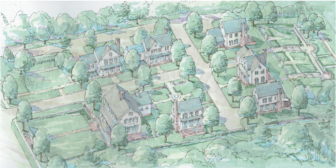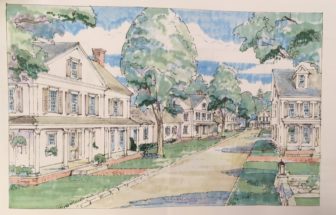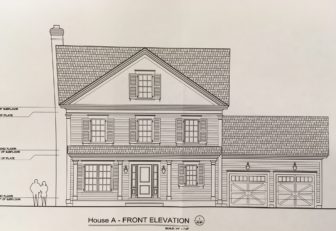The proposed redevelopment of the Roger Sherman Inn is too dense for its neighborhood and flies in the face of the documents that govern and guide zoning in New Canaan, an attorney representing opponents of the plan said Tuesday night.

Rendering of the proposed redevelopment of the Roger Sherman Inn site.
Creating seven single-family homes on the 1.8-acre lot at 195 Oenoke Ridge Road where the historic inn and restaurant now stand “really is not in keeping with the properties you see along Oenoke Ridge Road,” according to Amy Zabetakis of Darien-based Rucci Law Group. She represents six neighbors of the inn, on Holmewood and Hampton Lanes.
“I think you really need to take a big step back and really make sure that this is something you want to encourage in town,” she told members of the Planning & Zoning Commission during the first public hearing regarding the Roger Sherman Inn proposal, held at Town Hall.

Rendering of a future Roger Sherman Inn site.
“I was hoping to come here today that I would hear something from the applicant about how this plan does conform with the Plan of Conservation and Development, how it does conform with existing New Canaan regulations, because I think that is an essential part of your analysis. You are asked to make a text amendment and in order to approve a text amendment, you do have to have a finding affirmatively that this is in conformance with the town plan. Based on my reading of the town plan, this is not only not in conformance it is in fact totally opposite of what the Plan of Conservation and Development was directing you to do as you move forward with the regulations. The town plan asks you to maintain the open feeling of the larger lots. The town plan states that high density housing is only appropriate near town and should, in fact, be discouraged outside of town.”

Rendering of a future Roger Sherman Inn site home.
Filed by Norwalk-based Glazer Group on behalf of the property’s owners, plans call for a portion of the historic structure—at least part of it dates to 1740, tax records show—to be razed while what its oldest section would be converted into one of the seven new units (originally eight units, the proposal was scaled back following early discussions with the town planner). The 2.5-story detached dwellings would include about 2,600 square feet of living space with 2-car attached garages, applicant Andrew Glazer told the commission. (The plans may be viewed here, under the dropdown menu.)
In making his case, Glazer cited parts of the New Canaan Zoning Regulations (for example, see 7.1.A.2 on page 144 here) that appear to favor projects that bring a property into greater conformance.
Calling the proposed development for the site “less objectionable,” Glazer said the existing inn has a 135-seat dining room, 17 in-rooms and nearly 50 parking spaces.
“It operates a commercial business in a residential zone and it operates at night in manners that numbers of abutting property owners have voiced concerns to the current owners,” he said.
“About noise, disturbance, lights, late parties and things like that. We believe seven houses, somewhere between 10 to 14 people and maybe seven to 14 cars in an existing residential zone which is also surrounded by other unusual uses—churches and the Nature Center—is a highly less objectionable use than the current use. And based on that, we would say we think this is potentially an as-of-right project.”
Ultimately, P&Z continued the hearing to its next scheduled regular meeting, on Nov. 29.
Commissioners asked Glazer whether he was building anything on a 96-foot easement that runs east of the property (no, though offers had been made to purchase parts of that land), whether the condo association to be created here would maintain the planned gardens out back (yes), what is the footprint of the main house to be preserved (about 1,400 square feet, versus 1,000-square-foot footprint for the new homes), what are dimensions of gardens out back (about a half-acre), whether all of the units’ garages would come off of the driveway (yes), where visitors would be expected to park (in front of the hosts’ garages, though there’s a possibility of continuing overflow parking at First Presbyterian Church lot across the street, if needed), whether the state Route 124 sidewalk would be maintained (yes) and whether the fire marshal has yet reviewed plans (no).
Commissioner Kent Turner said it was “too bad” that the proposed new houses couldn’t be moved east (into the easement) because it would open up the house out front a bit more and give it a focus, as with the former Maples Inn property next door (also a Glazer project).
Glazer responded that there are plans to provide screening and “give more attention” to the house that is to be preserved from the inn structure.
“It’s funny if you really look at that, now I really study that house, the porch has been added on and it’s been sort of bastardized all over the place, but I found older photographs, which is what I used for guidelines of how to treat these older houses. And so I think as we clean it up, before people started adding on to it in weird ways, as we clean it up it will achieve its focus maybe even more than it ever has before. Right it now it is hidden behind these two monster pines, and you have this big blacktop area, so it’s a hodgepodge at this point.”
Michael Allen, president of the Maples Condominium Homeowners Association next door said his group voted 5-2 in support of the proposal for the Roger Sherman site. They did so, Allen said, for three main reasons: Screening is planned “to assure our continued privacy and safety’; The proposed density will be similar to what the Maples has now (about 14 people at two per dwelling); and “the traffic, floodlight and noise problems we have experienced from the Roger Sherman Inn restaurant will be substantially reduced.”
A holdout from a more rural era for New Canaan, the Roger Sherman has been under wide speculation since it hit the market at $6 million two years ago.
It’s owned by a limited liability company whose principal is Joseph Jaffre of Heritage Hill Road and whose agent is Nesreen Jaffre of Ridgefield, according to tax records and records on file with the Connecticut Secretary of the State. They bought it for $3,415,000 eight years ago, records show.
Glazer identified himself at the hearing as “the contract purchaser of the property” and his application included three proposed text amendments.
It was unclear from the meeting whether the proposed text amendments were appropriate or whether the commission would need them in order to move forward with some version of the project.
For example, Glazer proposes adding to a list of structures allowed by special permit (see page 45 here)—a list that currently includes things like elderly housing, congregate housing, B&Bs, group homes and religious institutions—the following: “Pre-existing non-conforming uses—where a pre-existing non-conforming commercial use is located within a residential zone a residential use may be permitted by special permit when the proposed use is residential and as a result o the residential use it reduces the non-conformity. The newly created residential use shall not exceed a density of six dwelling unit per 1 acre of land either attached or detached.”
Steve Kleppin, the former New Canaan town planner who is remaining as a consulting advisor for major applications such as this one while the town searches for his successor, said it wasn’t clear how many other commercial properties in town would qualify for the exception (nurseries on Frogtown and Old Stamford Roads being two examples).
Kleppin added that the ideal application for converting a business located in a residential zone such as the Roger Sherman would be for a single-family residence.
Town Attorney Ira Bloom, noting that he himself is not familiar with the particulars of Glazer’s application, noted that the town should proceed with caution regarding text amendments, since in this case the proposed development at the Roger Sherman “is not currently allowed under current zoning today.”
Bloom added that with respect to text changes, the commission must weigh two standards—first, whether the proposed changes are consistent with the town’s comprehensive plan of zoning (different from the POCD) and second, whether it is safe from a public health perspective.
Barry Frank, a resident of New Canaan for 17 years, said he regretted plans to change the use of Roger Sherman’s restaurant, which he likes.
Frank also recalled Glazer’s comments regarding the Maples Inn project hat he did next door.
“You talk about the design and mention the Maples Inn—if I may say, in my own opinion the Maples Inn is one of the ugliest buildings I’ve ever seen. Its only saving grace is that it is far away from the road so that you can barely see it. But it certainly is unattractive, plain and makes no statement. The Roger Sherman Inn is a classic historical building and I believe that that building should be maintained above all.”
Zabetakis in addressing P&Z referenced a letter filed with the commission on behalf of the neighbors she represents. It reads, in part, as follows:
“The Neighbors object to the pending application filed by Andy Glazer (the ‘Applicant’) to convert the property located at 196 Oenoke Ridge from a restaurant and inn to seven single family homes and request that it be denied by the Commission. Specifically the Neighbors object to the number of new homes proposed for the site which is well out of line with the underlying one acre zone and out of line with the current Plan of Conservation and Development (the ‘POCD’). The POCD specifically states on Page 16 that steps should be taken in New Canaan to preserve the “sense of ‘openness’ which results from large lot zoning” and to preserve Historic Buildings. The current Roger Sherman Inn structure is located on a 1.683 Acre parcel located in a one acre zone. Under the current regulations if the historic Roger Sherman Inn can no longer operate in this location, the lot should properly revert to one single family home on a large lot with a maximum building coverage of 4,611 square feet. Instead, the Applicant is proposing to build seven single family homes with building coverage of more than 10,980 square feet once porches are included in the calculation. This proposal is totally at odds with the POCD’s directive to preserve openness and, in fact, does just the opposite. The existing inn with all of its outbuildings has total coverage of 9,945 so the proposal will exceed even the existing coverage by more than 1000 square feet. The POCD further states on Page 66 that high density development is appropriate “in and near the downtown” but that high density housing ‘should be discouraged in other areas unless there is some significant community benefit that will result.’ The Applicant has not put forward any “significant community benefit” from this proposed high density development of seven single family homes on a single lot. The Application is also at odds with the protections provided within the New Canaan Zoning regulations regarding density and access. As mentioned above, the proposal calls for building coverage that is nearly three times the allowable for the zone, density that is seven times what is otherwise allowable in the zone and proposes to add seven homes to a driveway located within an easement that already serves six other residences. It is not enough to say that this extreme departure from the underlying zoning regulations is warranted because the existing use is commercial and the proposed use is residential. The existing commercial use is a legally nonconforming use that must be allowed to continue to operate in this location. If the location is no longer viable for the current use, the use of property should return to match the underlying zone. There is simply no support in the application, the New Canaan Zoning Regulation or the POCD for providing the Applicant with a text amendment to permit this project to go forward as designed. Section 8.2.3.e of the New Canaan Zoning Regulations states that a proposed regulation change should not be approved unless the Commission determines ‘that the proposed regulation change will aid in: (i) protecting the public health, safety, welfare or property values, and (ii) attaining the purposes of these Regulations.’ As discussed above, the proposed regulation change does not ‘aid in . . . attaining the purposes of’ the New Canaan Zoning Regulations. If anything, the proposal is completely contrary to the existing Regulations and POCD. For the forgoing reasons we respectfully request on behalf of the Neighbors that the Commission deny this application.